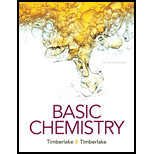
Concept explainers
(a)
Interpretation:
To determine the empirical formula of a compound having 70.9% K and 29.1% S atom.
Concept Introduction:
Steps to obtain empirical formula from given % of elements:
(b)
Interpretation:
To determine the empirical formula of a compound having 55.0% Ga and 45.0% F.
Concept Introduction:
Steps to obtain empirical formula from given % of elements:
(c)
Interpretation:
To determine the empirical formula of a compound having 31% B and 69.0 % O atoms.
Concept Introduction:
Steps to obtain empirical formula from given % of elements:
(d)
Interpretation:
To determine the empirical formula of a compound having 18.8% Li, 16.3% C, and 64.9% O atoms.
Concept Introduction:
Steps to obtain empirical formula from given % of elements:
(e)
Interpretation:
To determine the empirical formula of a compound having 51.7% C, 6.95 % H, and 41.3% O atoms.
Concept Introduction:
Steps to obtain empirical formula from given % of elements:
Want to see the full answer?
Check out a sample textbook solution
Chapter 7 Solutions
Basic Chemistry (5th Edition)
 ChemistryChemistryISBN:9781305957404Author:Steven S. Zumdahl, Susan A. Zumdahl, Donald J. DeCostePublisher:Cengage Learning
ChemistryChemistryISBN:9781305957404Author:Steven S. Zumdahl, Susan A. Zumdahl, Donald J. DeCostePublisher:Cengage Learning ChemistryChemistryISBN:9781259911156Author:Raymond Chang Dr., Jason Overby ProfessorPublisher:McGraw-Hill Education
ChemistryChemistryISBN:9781259911156Author:Raymond Chang Dr., Jason Overby ProfessorPublisher:McGraw-Hill Education Principles of Instrumental AnalysisChemistryISBN:9781305577213Author:Douglas A. Skoog, F. James Holler, Stanley R. CrouchPublisher:Cengage Learning
Principles of Instrumental AnalysisChemistryISBN:9781305577213Author:Douglas A. Skoog, F. James Holler, Stanley R. CrouchPublisher:Cengage Learning Organic ChemistryChemistryISBN:9780078021558Author:Janice Gorzynski Smith Dr.Publisher:McGraw-Hill Education
Organic ChemistryChemistryISBN:9780078021558Author:Janice Gorzynski Smith Dr.Publisher:McGraw-Hill Education Chemistry: Principles and ReactionsChemistryISBN:9781305079373Author:William L. Masterton, Cecile N. HurleyPublisher:Cengage Learning
Chemistry: Principles and ReactionsChemistryISBN:9781305079373Author:William L. Masterton, Cecile N. HurleyPublisher:Cengage Learning Elementary Principles of Chemical Processes, Bind...ChemistryISBN:9781118431221Author:Richard M. Felder, Ronald W. Rousseau, Lisa G. BullardPublisher:WILEY
Elementary Principles of Chemical Processes, Bind...ChemistryISBN:9781118431221Author:Richard M. Felder, Ronald W. Rousseau, Lisa G. BullardPublisher:WILEY





